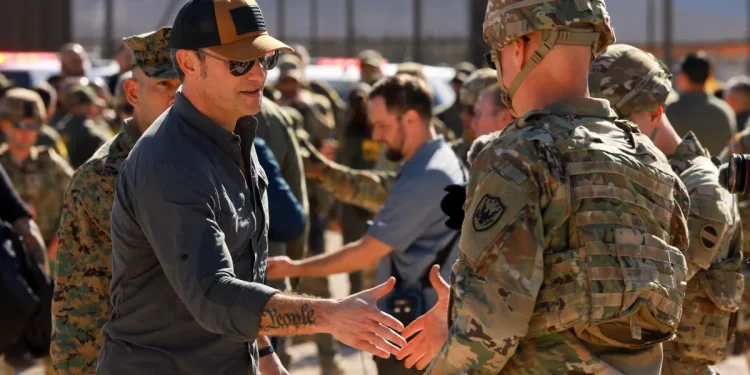Federal prosecutors in New Mexico have charged 28 individuals for crossing into the newly established 170-square-mile “National Defense Area” announced earlier this month by the Trump administration. President Trump authorized U.S. troops to detain anyone entering the U.S. from Mexico within this zone.
On Thursday, U.S. Attorney for New Mexico Ryan Ellison confirmed that his office filed trespassing charges against 82 people after a meeting with Defense Secretary Pete Hegseth and U.S. Border Patrol Chief Michael Banks.
The first 28 arrests took place over a three-day span starting April 24. Those individuals were charged with unauthorized entry into the U.S. and for “willfully” violating the newly declared National Defense Area. This zone, situated along the 60-foot Roosevelt Reservation, is now considered part of a U.S. military installation.
As of Thursday afternoon, a search of court records by the Tucson Sentinel did not reveal filings for the additional 54 cases, nor have any charges appeared in Arizona records yet.
These are the first cases stemming from the administration’s efforts to bypass existing federal laws, which prohibit active-duty troops from performing law enforcement duties such as searches or arrests of migrants. The Washington Post first reported Monday’s prosecutions.
The charges were filed in U.S. District Court in Las Cruces and include illegal entry without inspection—a federal misdemeanor. Violating military installation security regulations can carry penalties of up to a year in prison or a fine.
In 2024, only 46 people nationwide were charged with breaching military installations under federal law, with just 16 convictions, according to data from the Transactional Records Access Clearinghouse.
This new defense area is part of a series of executive orders issued by President Trump aimed at tightening border control. Just hours after taking office, Trump declared that “America’s sovereignty is under attack.”
“Our southern border is overrun by cartels, criminal gangs, known terrorists, human traffickers, smugglers, unvetted military-age males from foreign adversaries, and illicit narcotics that harm Americans, including America,” Trump said.
His order ramped up military presence along the border, deploying multiple units—including infantry, military police, and Stryker brigades equipped with armored vehicles and surveillance gear—to locations like Yuma and Ft. Huachuca.
A photo released by Ellison showed him standing beside Hegseth and Banks next to a Stryker vehicle.
“The Department of Justice will work hand in glove with the Department of Defense and Border Patrol to gain 100% operational control of New Mexico’s 170-mile border with Mexico,” Ellison said. “Trespassers into the National Defense Area will be federally prosecuted — no exceptions.”
Trump Hands Over Federal Land to Military Control
On April 11, President Trump directed the transfer of the Roosevelt Reservation—a 60-foot-wide federal easement along California, Arizona, and New Mexico’s southern borders—to military jurisdiction, designating it as a “National Defense Area.”
Interior Secretary Doug Burgum followed through, transferring nearly 110,000 acres in New Mexico to the Army for a three-year period. He said the move was meant to protect the area’s natural and cultural assets while supporting Border Patrol in securing the border and stopping illegal immigration.
“Securing our border and protecting our nation’s resources go hand in hand,” Burgum stated. “The American people gave President Trump a mandate to make America safe and strong again. This transfer reflects Interior’s commitment to public safety, national security and responsible stewardship of our public lands.”
Under the agreement, the Defense Department assumes jurisdiction over parts of the easement—excluding Native American lands like the Tohono O’odham Nation. That reservation’s 63-mile border with Mexico is guarded by bollards designed to block vehicles, but it may see increased migrant crossings, according to Cronkite News.
Though the easement itself spans only 60 feet, a map from the Bureau of Land Management shows the “emergency withdrawal area” extends up to 3.5 miles inland from New Mexico’s southern border, except in wilderness study areas, as reported by the Arizona Daily Star.
This effectively creates a new 170-square-mile military zone—without congressional approval.
Military Expands Role at Southern Border
While Arizona’s easement remains under civilian control, the newly declared New Mexico National Defense Area is now overseen by the U.S. Army garrison at Ft. Huachuca, operating under U.S. Northern Command.
According to the Defense Department, military personnel will collaborate with CBP to enforce perimeter control, prevent mass migration, and counter criminal activities such as drug trafficking and human smuggling.
Troops are authorized to install temporary barriers, monitor activity, apprehend intruders, and post signage to mark restricted areas.
Stryker vehicles have been deployed to Nogales, Douglas, and Ajo, Arizona. The military and CBP have heavily promoted their presence on social media—often featuring armored Strykers rolling behind Border Patrol SUVs, accompanied by hard rock music.
The military buffer zone now stretches across the U.S.-Mexico border in California, Arizona, and New Mexico. Migrants crossing into these zones face arrest by active-duty soldiers until Border Patrol can take over.
This expansion pushes the limits of the Posse Comitatus Act, which traditionally bars federal troops from law enforcement roles. While the law allows the military to provide support—such as surveillance or logistics—it restricts direct police actions unless specifically authorized by law.
“Posse comitatus” originated in the era before formal law enforcement, referring to a group of civilians assembled to help maintain order.
The act does not apply to National Guard troops when under state command.
Previous administrations, including President Clinton’s, deployed troops in limited support roles—repairing vehicles, tending to horses, operating sensors, and flying surveillance missions. But under Trump, military personnel have taken on expanded responsibilities, including drone operations and “screening” missions in Yuma. Naval warships have even been sent to patrol coastal areas.
With the new defense zone in place, roughly 10,000 active-duty service members now have the authority to arrest individuals—whether migrants or U.S. citizens—within the designated areas.
As part of his January 20 executive order, Trump instructed Defense Secretary Pete Hegseth and Homeland Security Secretary Kristi Noem to produce a joint report on the southern border’s condition. The report was also to include recommendations, possibly including invocation of the Insurrection Act of 1807.
That law allows the president to use military or federalized National Guard forces to quash domestic unrest and suspends the Posse Comitatus Act, effectively giving the military law enforcement powers.
Though the deadline for the report has passed, Hegseth and Noem have not yet advocated for invoking the act—though the option remains on the table.









